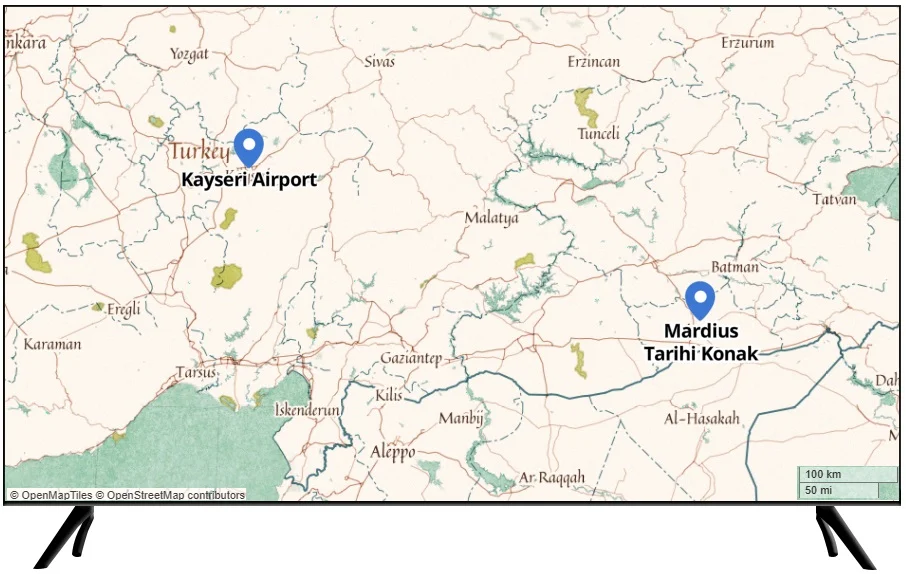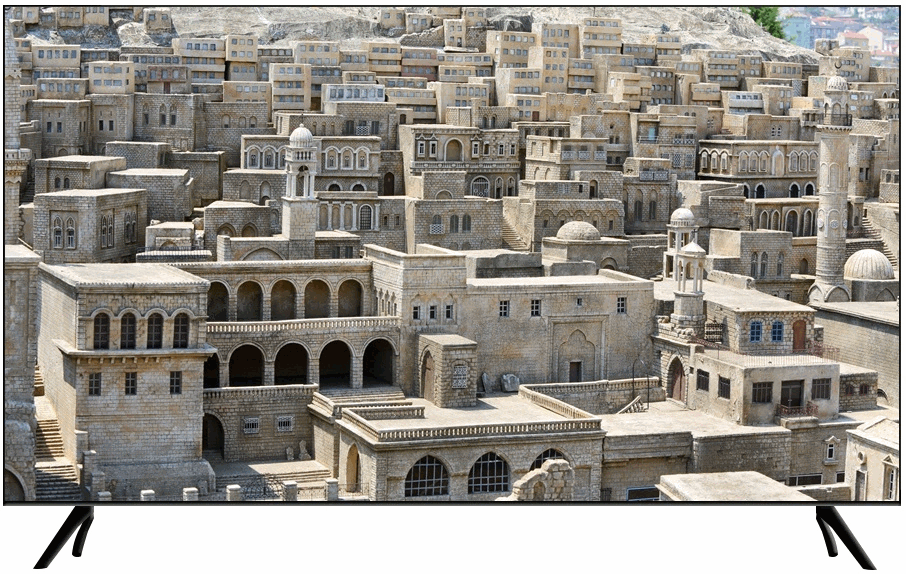


Day 7. Cappadocia – Mardin (Mesopotamia)
Overnight – Mardius Tarihi Konak
In the mid-morning you are driven to Kayseri Airport and assisted in boarding your connecting flight (via Istanbul) to Mardin. The first flight leg is in business, the second is only possible in coach. Arrive in Mesopotamia in the early evening and you are driven to your extremely unique and charming lodging and assisted with your check-in. The Mardius Tarihi Konak in Mardin is a striking example of traditional Anatolian architecture, offering visitors a glimpse into the rich history and culture of the region.
Situated within the ancient city walls of Mardin’s old town, this historic mansion exudes an aura of timeless elegance and charm. Its imposing stone facade, adorned with intricate carvings and decorative motifs that reflect the craftsmanship of generations past. Stepping inside, visitors are transported to a bygone era, where opulence and refinement were the hallmarks of aristocratic life. The interior of the Mardius Tarihi Konak is adorned with exquisite furnishings, hand-woven carpets, and antique artifacts, creating an atmosphere of old-world grandeur and sophistication.
Perched atop the lofty “Mardin High,” a geological masterpiece born from the collision of the Arabian and Eurasian plates, this pale mustard-hued city commands the vast Mesopotamian plains below, where the Tigris and Euphrates rivers wind their way through the landscape like lifelines of civilization. Ancient Mardin city exudes an enchanting blend of history, culture, and natural beauty. Mardin’s unique limestone architecture, characterized by intricately carved pale mustard-colored stone facades, ornate mosques, and ancient churches.
The city’s vibrant bazaars, where merchants sell colorful spices, textiles, and handicrafts, buzz with activity, offering visitors a glimpse into Mardin’s bustling past as a center of trade and commerce. The Tigris and Euphrates rivers, often referred to as the “cradle of civilization,” have played a central role in shaping the history and culture of the region. These ancient waterways have nourished the fertile lands of Mesopotamia for millennia, sustaining civilizations such as the Sumerians, Babylonians, and Assyrians, whose legacies are still evident in the archaeological sites and ruins scattered along their banks.
Today, the Tigris and Euphrates rivers continue to be vital lifelines for the people of Mardin and the surrounding region, providing water for irrigation, transportation, and sustenance.
Situated within the ancient city walls of Mardin’s old town, this historic mansion exudes an aura of timeless elegance and charm. Its imposing stone facade, adorned with intricate carvings and decorative motifs that reflect the craftsmanship of generations past. Stepping inside, visitors are transported to a bygone era, where opulence and refinement were the hallmarks of aristocratic life. The interior of the Mardius Tarihi Konak is adorned with exquisite furnishings, hand-woven carpets, and antique artifacts, creating an atmosphere of old-world grandeur and sophistication.
Perched atop the lofty “Mardin High,” a geological masterpiece born from the collision of the Arabian and Eurasian plates, this pale mustard-hued city commands the vast Mesopotamian plains below, where the Tigris and Euphrates rivers wind their way through the landscape like lifelines of civilization. Ancient Mardin city exudes an enchanting blend of history, culture, and natural beauty. Mardin’s unique limestone architecture, characterized by intricately carved pale mustard-colored stone facades, ornate mosques, and ancient churches.
The city’s vibrant bazaars, where merchants sell colorful spices, textiles, and handicrafts, buzz with activity, offering visitors a glimpse into Mardin’s bustling past as a center of trade and commerce. The Tigris and Euphrates rivers, often referred to as the “cradle of civilization,” have played a central role in shaping the history and culture of the region. These ancient waterways have nourished the fertile lands of Mesopotamia for millennia, sustaining civilizations such as the Sumerians, Babylonians, and Assyrians, whose legacies are still evident in the archaeological sites and ruins scattered along their banks.
Today, the Tigris and Euphrates rivers continue to be vital lifelines for the people of Mardin and the surrounding region, providing water for irrigation, transportation, and sustenance.
In the mid-morning you are driven to Kayseri Airport and assisted in boarding your connecting flight (via Istanbul) to Mardin. The first flight leg is in business, the second is only possible in coach. Arrive in Mesopotamia in the early evening and you are driven to your extremely unique and charming lodging and assisted with your check-in. The Mardius Tarihi Konak in Mardin is a striking example of traditional Anatolian architecture, offering visitors a glimpse into the rich history and culture of the region.
Situated within the ancient city walls of Mardin’s old town, this historic mansion exudes an aura of timeless elegance and charm. Its imposing stone facade, adorned with intricate carvings and decorative motifs that reflect the craftsmanship of generations past. Stepping inside, visitors are transported to a bygone era, where opulence and refinement were the hallmarks of aristocratic life. The interior of the Mardius Tarihi Konak is adorned with exquisite furnishings, hand-woven carpets, and antique artifacts, creating an atmosphere of old-world grandeur and sophistication.
Perched atop the lofty “Mardin High,” a geological masterpiece born from the collision of the Arabian and Eurasian plates, this pale mustard-hued city commands the vast Mesopotamian plains below, where the Tigris and Euphrates rivers wind their way through the landscape like lifelines of civilization. Ancient Mardin city exudes an enchanting blend of history, culture, and natural beauty. Mardin’s unique limestone architecture, characterized by intricately carved pale mustard-colored stone facades, ornate mosques, and ancient churches.
The city’s vibrant bazaars, where merchants sell colorful spices, textiles, and handicrafts, buzz with activity, offering visitors a glimpse into Mardin’s bustling past as a center of trade and commerce. The Tigris and Euphrates rivers, often referred to as the “cradle of civilization,” have played a central role in shaping the history and culture of the region. These ancient waterways have nourished the fertile lands of Mesopotamia for millennia, sustaining civilizations such as the Sumerians, Babylonians, and Assyrians, whose legacies are still evident in the archaeological sites and ruins scattered along their banks.
Today, the Tigris and Euphrates rivers continue to be vital lifelines for the people of Mardin and the surrounding region, providing water for irrigation, transportation, and sustenance.
Situated within the ancient city walls of Mardin’s old town, this historic mansion exudes an aura of timeless elegance and charm. Its imposing stone facade, adorned with intricate carvings and decorative motifs that reflect the craftsmanship of generations past. Stepping inside, visitors are transported to a bygone era, where opulence and refinement were the hallmarks of aristocratic life. The interior of the Mardius Tarihi Konak is adorned with exquisite furnishings, hand-woven carpets, and antique artifacts, creating an atmosphere of old-world grandeur and sophistication.
Perched atop the lofty “Mardin High,” a geological masterpiece born from the collision of the Arabian and Eurasian plates, this pale mustard-hued city commands the vast Mesopotamian plains below, where the Tigris and Euphrates rivers wind their way through the landscape like lifelines of civilization. Ancient Mardin city exudes an enchanting blend of history, culture, and natural beauty. Mardin’s unique limestone architecture, characterized by intricately carved pale mustard-colored stone facades, ornate mosques, and ancient churches.
The city’s vibrant bazaars, where merchants sell colorful spices, textiles, and handicrafts, buzz with activity, offering visitors a glimpse into Mardin’s bustling past as a center of trade and commerce. The Tigris and Euphrates rivers, often referred to as the “cradle of civilization,” have played a central role in shaping the history and culture of the region. These ancient waterways have nourished the fertile lands of Mesopotamia for millennia, sustaining civilizations such as the Sumerians, Babylonians, and Assyrians, whose legacies are still evident in the archaeological sites and ruins scattered along their banks.
Today, the Tigris and Euphrates rivers continue to be vital lifelines for the people of Mardin and the surrounding region, providing water for irrigation, transportation, and sustenance.

